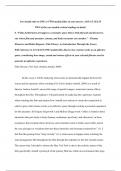You should refer to ONE or TWO module films in your answer. AND AT LEAST
TWO of the core module critical readings in detail.
8. “Films furthermore presuppose a cinematic space that is both physical and discursive,
one where film and spectator, cinema, and body encounter one another.” - Thomas
Elsaesser and Malte Hagener, Film Theory: An Introduction Through the Senses
With reference to AT LEAST ONE module film, discuss how cinema works as an affective
space, considering how image, sound and various effects in your selected film are used to
generate an affective experience.
Film Chosen: Fish Tank (Andrea Arnold, 2009)
In this essay, I will be analysing what seems to automatically happen between the
screen and the spectator when watching Fish Tank (Andrea Arnold, 2009) as a result of
director Andrea Arnold’s successful usage of specific images, sound and various effects
throughout the film. Throughout, I will particularly be analysing the experience I gained
when watching the film and analyse how Arnold uses realism to create this connection in
order to prove that cinema works as an affective space through creating a personal experience
for the spectator. In Gregory Seigworth’s and Melissa Gregg words “Affect is found in those
intensities that pass body to body (human, nonhuman, part-body, and otherwise), in those
resonances that circulate about, between, and sometimes stick to bodies and worlds, and in
the very passages or variations between these intensities and resonances themselves” (1). I
feel that this passing from “body to body” (1) is what seems to happen when watching the
main protagonists Mia throughout the film through the empathy for her that Arnold creates.
The reason why I decided to choose the film Fish Tank is due to the realistic nature of the
film specifically Arnold’s portrayal of the journey Mia has within an environment that stops
, her from doing what she loves. Throughout, Arnold proves that she can work skillfully with
this idea of realism and therefore create an affective experience for the spectator. Realism
plays a key part in this film and the result of that is the audience gaining an empathic
experience. Arnold takes advantage of making the film as realistic as possible in order for the
viewer to see the protagonist of the film, Mia, as someone who you could easily relate to.
When watching the film, the viewer sees the action from the perspective of Mia,
skilfully done through camera angles which face in the direction as if the camera is looking
from her perspective. While the audience see the action from the perspective of Mia, an
isolated girl on a path set for her in a society she feels that she does not belong. There is a
constant feeling of entrapment throughout the entirety of the film which is reflected onto the
spectator through Arnold’s use of image and sound techniques. Eric Shouse similarly argues
like Seigworth and notes that “the transmission of affect is about the way that bodies affect
one another. When your body infolds a context and another body (real or virtual) is
expressing intensity in that context, one intensity is infolded into another.”(6) When watching
Mia throughout the film, Arnold usually puts Mia solely in the centre of the frame and as the
film goes on one empathises with her character more as she seems almost secluded from the
rest of the characters and seemingly only to be just her with the spectator of the film. As well
as this, image, sound and various effects are used throughout to create an immersive yet
isolated feel to scenes in order to create a connection with the viewer and the screen. The
name of the film itself, Fish Tank, is indicative of Mia’s situation and that she is trapped in a
never-changing reality that she is unable to escape, and Arnold positions her in the frame and
setting as if she is trapped in the film screen, as if trapped in a Fish Tank. Another way
Arnold emphasises Mia’s entrapment within her society is positioning Mia in the film frame
in proximity to a window in the film frame, her either glaring out the window or being filmed




